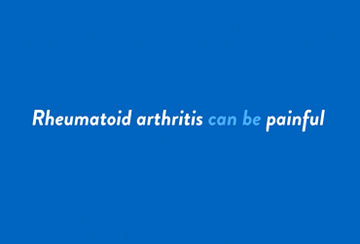Rheumatoid arthritis (RA) affects thousands of Canadians, but it’s often an invisible condition — someone close to you could have it and you wouldn’t necessarily know. What do people who have RA experience? What do they wish others could see? Read on and find out.
A disease that can be invisible
RA is an autoimmune and inflammatory disease that causes one’s body to mistakenly attack the lining of the joints,A resulting in pain, stiffness and swelling.B The symptoms of the disease differ in each person’s case, and can start in the joints — in the hands, wrists and knees, for example — but RA can also affect tissues in other parts of the body, including the nerves, eyes, lungs and heart.C
RA affects women two or three times as often as men. Around one in 100 Canadian adults has it — so there’s a good chance you know one of the approximately 300,000 Canadians who do.1
Even if there is someone in your life with RA, could their disease be invisible? Quite possibly. While the swelling due to RA can result in bone erosion and joint deformity in some patients,2 symptoms can be invisible in others.3 And some people who have the disease hide it from family and friends, because others are not empathetic, or the person with RA doesn’t want to be perceived as a complainer.4
Rheumatoid arthritis can be difficult to see
The symptoms can vary quite a bit from person to person, ranging from mild joint pain and swelling5 as well as fatigue, fever and loss of appetite6; 5 per cent of people with RA experience extensive pain and disability.7
What do these symptoms have in common? They can be difficult for others to see.
Living with RA means dealing with variable symptoms — some days are worse than others, and a patient may not know what tomorrow will bring.D People living with RA sometimes report feeling as if the disease had taken control of their bodies.8 The disease can lower quality of life and pose challenges when it comes to employment.9
In other words, the future can be hard to see clearly if you have RA.
Seeing through the misconceptions
The word “arthritis” might conjure up images of advanced age, but RA can affect people at all stages of life. While RA is more likely to affect people as they get older, it most often begins between the ages of 30 and 50, and plenty of people who have it are under 30.10,11,12
Another possible misconception: RA is debilitating, and people who have it are forced to be physically inactive. It used to be that high-intensity exercise was not recommended for RA patients, but now there’s evidence that it can be beneficial (with guidance from one’s doctor).13 Some people with RA can potentially enjoy all kinds of physical endeavours — like climbing mountains, competing in triathlons and taking part in long-distance races.14,15,16
Not only is physical activity possible with RA, it’s recommended. People with RA are at an increased risk of mortality related to cardiovascular events, which makes an active lifestyle especially important.17
Another misconception to dispel: In the past, some doctors didn’t always believe that comprehensive care plans could change long-term outcomes for RA patients.18 It’s different now. While there is no cure for RA, appropriate care can help.19,20,21
That’s why if you or someone close to you has RA, it’s important to remember that it is possible to see a clear path forward with the disease.
A Arthritis Society (Canada) (What is rheumatoid arthritis?)
B Arthritis Society (Canada) (What is rheumatoid arthritis?)
C Arthritis Society (Canada) (What is rheumatoid arthritis?)
1 Arthritis Society (Canada) (What is rheumatoid arthritis?)
2 Mayo Clinic (Overview)
3 BMC Rheumatology (Section: Results > ‘Rheumatoid arthritis is invisible’, p. 16)
4 BMC Rheumatology (Section: Results > ‘Rheumatoid arthritis is invisible’, p. 17 — Also, please read ‘Methods’ section starting on p. 4, which explains that first-person statements in
the results are ethnographic abstractions intended to represent the reelings of multiple study subjects)
5 BMC Rheumatology (Section: Background, p. 3)
6 Mayo Clinic (Section: ‘Symptoms’)
7 BMC Rheumatology (Section: Background, p. 3)
D BMC Rheumatology (Section: Results > ‘Rheumatoid arthritis is in control of my body,’ p. 10)
8 BMC Rheumatology (Section: Results > ‘Rheumatoid arthritis is in control of my body,’ p. 10)
9 Centers for Disease Control (Section: What are the complications of RA?)
10 Centers for Disease Control (What are the risk factors for RA?)
11 American College of Rheumatology (Section: What is rheumatoid arthritis)
12 ResearchGate (See table 1)
13 Arthritis Foundation - High-intensity Exercise (Paragraph 1)
14 Arthritis Foundation - Climbing Mountains (Paragraph 1)
15 Asbury Park Press (Headline)
16 Arthritis Foundation - Defying Gravity (Page 1)
17 Journal of Physical Activty and Health Journal of Physical Activity and Health 9.7 (2012): 1036-1048. (Section: Introduction)
18 Cleveland Clinic (Section: What are the goals of treating rheumatoid arthritis?)
19 Arthritis Society (What is rheumatoid arthritis?)
20 BMC Rheumatology (Section: Background)
21 Cleveland Clinic (Section: What are the goals of treating rheumatoid arthritis?)


